Kybernetes: Consumer Attitudes Toward Online Video Advertisement
VerifiedAdded on 2021/07/20
|16
|8133
|156
Report
AI Summary
This research paper, titled "Consumer attitudes toward online video advertisement: YouTube as a platform," published in Kybernetes, investigates consumer attitudes towards advertisements on YouTube. The study employs Brackett and Carr’s Web Advertising Attitudes Model, integrating it with the theory of reasoned action and flow theory to understand the factors influencing consumer attitudes, shopping intention, and purchase behavior. Key findings reveal the impact of entertainment, informativeness, irritation, and credibility on shopping attitudes, while flow significantly influences shopping intention and purchase behavior. The research provides a comprehensive model for online video advertisement, offering a framework for researchers to capture a complete picture of the relevant phenomena. The paper also includes a literature review on flow theory, attitudes toward internet advertising, and relevant variables such as informativeness and irritation, providing a valuable academic and practitioner reference.
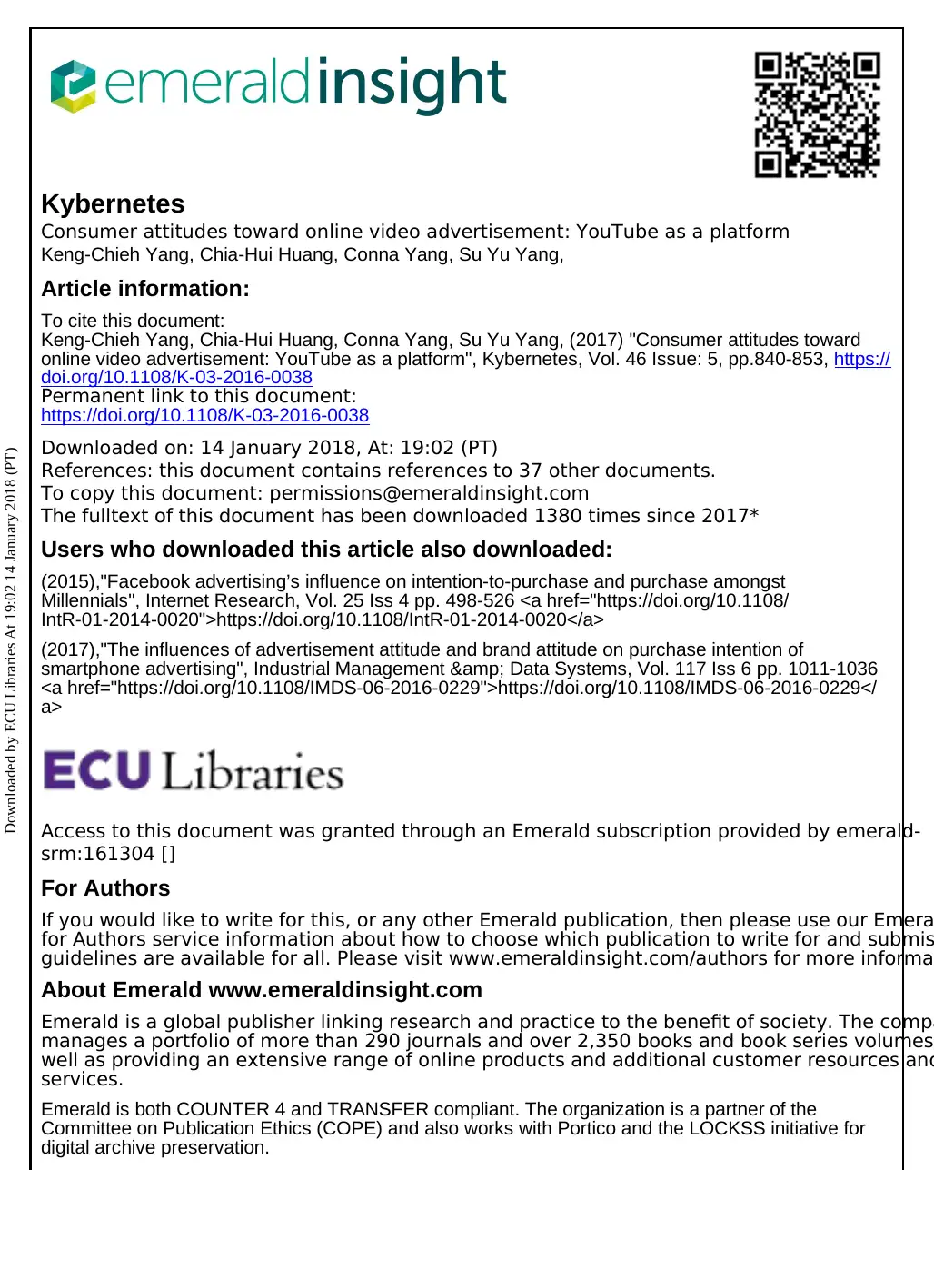
Kybernetes
Consumer attitudes toward online video advertisement: YouTube as a platform
Keng-Chieh Yang, Chia-Hui Huang, Conna Yang, Su Yu Yang,
Article information:
To cite this document:
Keng-Chieh Yang, Chia-Hui Huang, Conna Yang, Su Yu Yang, (2017) "Consumer attitudes toward
online video advertisement: YouTube as a platform", Kybernetes, Vol. 46 Issue: 5, pp.840-853, https://
doi.org/10.1108/K-03-2016-0038
Permanent link to this document:
https://doi.org/10.1108/K-03-2016-0038
Downloaded on: 14 January 2018, At: 19:02 (PT)
References: this document contains references to 37 other documents.
To copy this document: permissions@emeraldinsight.com
The fulltext of this document has been downloaded 1380 times since 2017*
Users who downloaded this article also downloaded:
(2015),"Facebook advertising’s influence on intention-to-purchase and purchase amongst
Millennials", Internet Research, Vol. 25 Iss 4 pp. 498-526 <a href="https://doi.org/10.1108/
IntR-01-2014-0020">https://doi.org/10.1108/IntR-01-2014-0020</a>
(2017),"The influences of advertisement attitude and brand attitude on purchase intention of
smartphone advertising", Industrial Management & Data Systems, Vol. 117 Iss 6 pp. 1011-1036
<a href="https://doi.org/10.1108/IMDS-06-2016-0229">https://doi.org/10.1108/IMDS-06-2016-0229</
a>
Access to this document was granted through an Emerald subscription provided by emerald-
srm:161304 []
For Authors
If you would like to write for this, or any other Emerald publication, then please use our Emera
for Authors service information about how to choose which publication to write for and submis
guidelines are available for all. Please visit www.emeraldinsight.com/authors for more informa
About Emerald www.emeraldinsight.com
Emerald is a global publisher linking research and practice to the benefit of society. The compa
manages a portfolio of more than 290 journals and over 2,350 books and book series volumes
well as providing an extensive range of online products and additional customer resources and
services.
Emerald is both COUNTER 4 and TRANSFER compliant. The organization is a partner of the
Committee on Publication Ethics (COPE) and also works with Portico and the LOCKSS initiative for
digital archive preservation.
Downloaded by ECU Libraries At 19:02 14 January 2018 (PT)
Consumer attitudes toward online video advertisement: YouTube as a platform
Keng-Chieh Yang, Chia-Hui Huang, Conna Yang, Su Yu Yang,
Article information:
To cite this document:
Keng-Chieh Yang, Chia-Hui Huang, Conna Yang, Su Yu Yang, (2017) "Consumer attitudes toward
online video advertisement: YouTube as a platform", Kybernetes, Vol. 46 Issue: 5, pp.840-853, https://
doi.org/10.1108/K-03-2016-0038
Permanent link to this document:
https://doi.org/10.1108/K-03-2016-0038
Downloaded on: 14 January 2018, At: 19:02 (PT)
References: this document contains references to 37 other documents.
To copy this document: permissions@emeraldinsight.com
The fulltext of this document has been downloaded 1380 times since 2017*
Users who downloaded this article also downloaded:
(2015),"Facebook advertising’s influence on intention-to-purchase and purchase amongst
Millennials", Internet Research, Vol. 25 Iss 4 pp. 498-526 <a href="https://doi.org/10.1108/
IntR-01-2014-0020">https://doi.org/10.1108/IntR-01-2014-0020</a>
(2017),"The influences of advertisement attitude and brand attitude on purchase intention of
smartphone advertising", Industrial Management & Data Systems, Vol. 117 Iss 6 pp. 1011-1036
<a href="https://doi.org/10.1108/IMDS-06-2016-0229">https://doi.org/10.1108/IMDS-06-2016-0229</
a>
Access to this document was granted through an Emerald subscription provided by emerald-
srm:161304 []
For Authors
If you would like to write for this, or any other Emerald publication, then please use our Emera
for Authors service information about how to choose which publication to write for and submis
guidelines are available for all. Please visit www.emeraldinsight.com/authors for more informa
About Emerald www.emeraldinsight.com
Emerald is a global publisher linking research and practice to the benefit of society. The compa
manages a portfolio of more than 290 journals and over 2,350 books and book series volumes
well as providing an extensive range of online products and additional customer resources and
services.
Emerald is both COUNTER 4 and TRANSFER compliant. The organization is a partner of the
Committee on Publication Ethics (COPE) and also works with Portico and the LOCKSS initiative for
digital archive preservation.
Downloaded by ECU Libraries At 19:02 14 January 2018 (PT)
Paraphrase This Document
Need a fresh take? Get an instant paraphrase of this document with our AI Paraphraser

*Related content and download information correct at time of download.
Downloaded by ECU Libraries At 19:02 14 January 2018 (PT)
Downloaded by ECU Libraries At 19:02 14 January 2018 (PT)
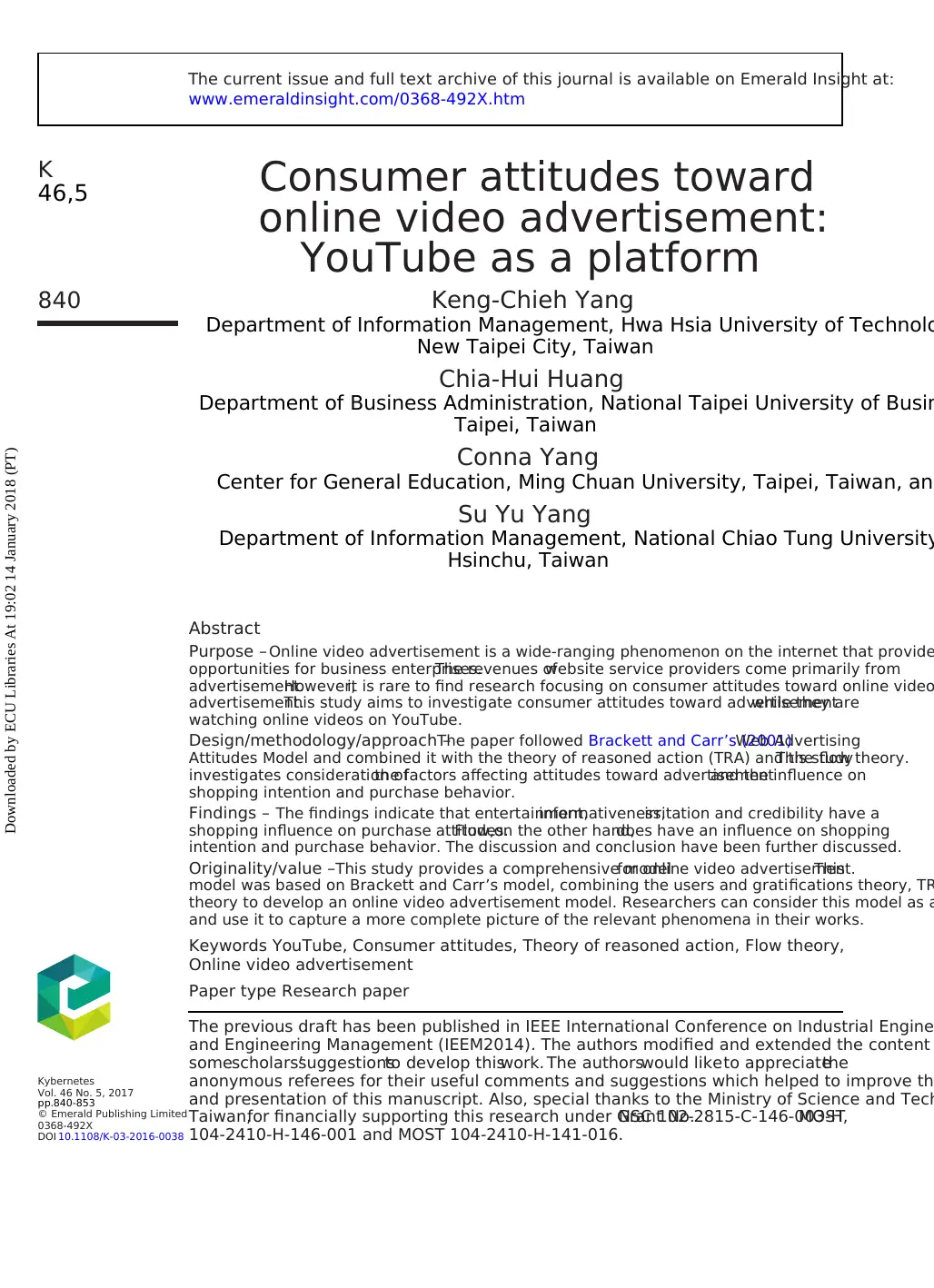
Consumer attitudes toward
online video advertisement:
YouTube as a platform
Keng-Chieh Yang
Department of Information Management, Hwa Hsia University of Technolo
New Taipei City, Taiwan
Chia-Hui Huang
Department of Business Administration, National Taipei University of Busin
Taipei, Taiwan
Conna Yang
Center for General Education, Ming Chuan University, Taipei, Taiwan, and
Su Yu Yang
Department of Information Management, National Chiao Tung University
Hsinchu, Taiwan
Abstract
Purpose – Online video advertisement is a wide-ranging phenomenon on the internet that provide
opportunities for business enterprises.The revenues ofwebsite service providers come primarily from
advertisement.However,it is rare to find research focusing on consumer attitudes toward online video
advertisement.This study aims to investigate consumer attitudes toward advertisementwhile they are
watching online videos on YouTube.
Design/methodology/approach –The paper followed Brackett and Carr’s (2001)Web Advertising
Attitudes Model and combined it with the theory of reasoned action (TRA) and the flow theory.This study
investigates consideration ofthe factors affecting attitudes toward advertisementand the influence on
shopping intention and purchase behavior.
Findings – The findings indicate that entertainment,informativeness,irritation and credibility have a
shopping influence on purchase attitudes.Flow,on the other hand,does have an influence on shopping
intention and purchase behavior. The discussion and conclusion have been further discussed.
Originality/value –This study provides a comprehensive modelfor online video advertisement.This
model was based on Brackett and Carr’s model, combining the users and gratifications theory, TR
theory to develop an online video advertisement model. Researchers can consider this model as a
and use it to capture a more complete picture of the relevant phenomena in their works.
Keywords YouTube, Consumer attitudes, Theory of reasoned action, Flow theory,
Online video advertisement
Paper type Research paper
The previous draft has been published in IEEE International Conference on Industrial Engine
and Engineering Management (IEEM2014). The authors modified and extended the content
somescholars’suggestionsto develop thiswork. The authorswould liketo appreciatethe
anonymous referees for their useful comments and suggestions which helped to improve th
and presentation of this manuscript. Also, special thanks to the Ministry of Science and Tech
Taiwan,for financially supporting this research under Grant No.NSC 102-2815-C-146-003-H,MOST
104-2410-H-146-001 and MOST 104-2410-H-141-016.
K
46,5
840
Kybernetes
Vol. 46 No. 5, 2017
pp.840-853
© Emerald Publishing Limited
0368-492X
DOI 10.1108/K-03-2016-0038
The current issue and full text archive of this journal is available on Emerald Insight at:
www.emeraldinsight.com/0368-492X.htm
Downloaded by ECU Libraries At 19:02 14 January 2018 (PT)
online video advertisement:
YouTube as a platform
Keng-Chieh Yang
Department of Information Management, Hwa Hsia University of Technolo
New Taipei City, Taiwan
Chia-Hui Huang
Department of Business Administration, National Taipei University of Busin
Taipei, Taiwan
Conna Yang
Center for General Education, Ming Chuan University, Taipei, Taiwan, and
Su Yu Yang
Department of Information Management, National Chiao Tung University
Hsinchu, Taiwan
Abstract
Purpose – Online video advertisement is a wide-ranging phenomenon on the internet that provide
opportunities for business enterprises.The revenues ofwebsite service providers come primarily from
advertisement.However,it is rare to find research focusing on consumer attitudes toward online video
advertisement.This study aims to investigate consumer attitudes toward advertisementwhile they are
watching online videos on YouTube.
Design/methodology/approach –The paper followed Brackett and Carr’s (2001)Web Advertising
Attitudes Model and combined it with the theory of reasoned action (TRA) and the flow theory.This study
investigates consideration ofthe factors affecting attitudes toward advertisementand the influence on
shopping intention and purchase behavior.
Findings – The findings indicate that entertainment,informativeness,irritation and credibility have a
shopping influence on purchase attitudes.Flow,on the other hand,does have an influence on shopping
intention and purchase behavior. The discussion and conclusion have been further discussed.
Originality/value –This study provides a comprehensive modelfor online video advertisement.This
model was based on Brackett and Carr’s model, combining the users and gratifications theory, TR
theory to develop an online video advertisement model. Researchers can consider this model as a
and use it to capture a more complete picture of the relevant phenomena in their works.
Keywords YouTube, Consumer attitudes, Theory of reasoned action, Flow theory,
Online video advertisement
Paper type Research paper
The previous draft has been published in IEEE International Conference on Industrial Engine
and Engineering Management (IEEM2014). The authors modified and extended the content
somescholars’suggestionsto develop thiswork. The authorswould liketo appreciatethe
anonymous referees for their useful comments and suggestions which helped to improve th
and presentation of this manuscript. Also, special thanks to the Ministry of Science and Tech
Taiwan,for financially supporting this research under Grant No.NSC 102-2815-C-146-003-H,MOST
104-2410-H-146-001 and MOST 104-2410-H-141-016.
K
46,5
840
Kybernetes
Vol. 46 No. 5, 2017
pp.840-853
© Emerald Publishing Limited
0368-492X
DOI 10.1108/K-03-2016-0038
The current issue and full text archive of this journal is available on Emerald Insight at:
www.emeraldinsight.com/0368-492X.htm
Downloaded by ECU Libraries At 19:02 14 January 2018 (PT)
⊘ This is a preview!⊘
Do you want full access?
Subscribe today to unlock all pages.

Trusted by 1+ million students worldwide
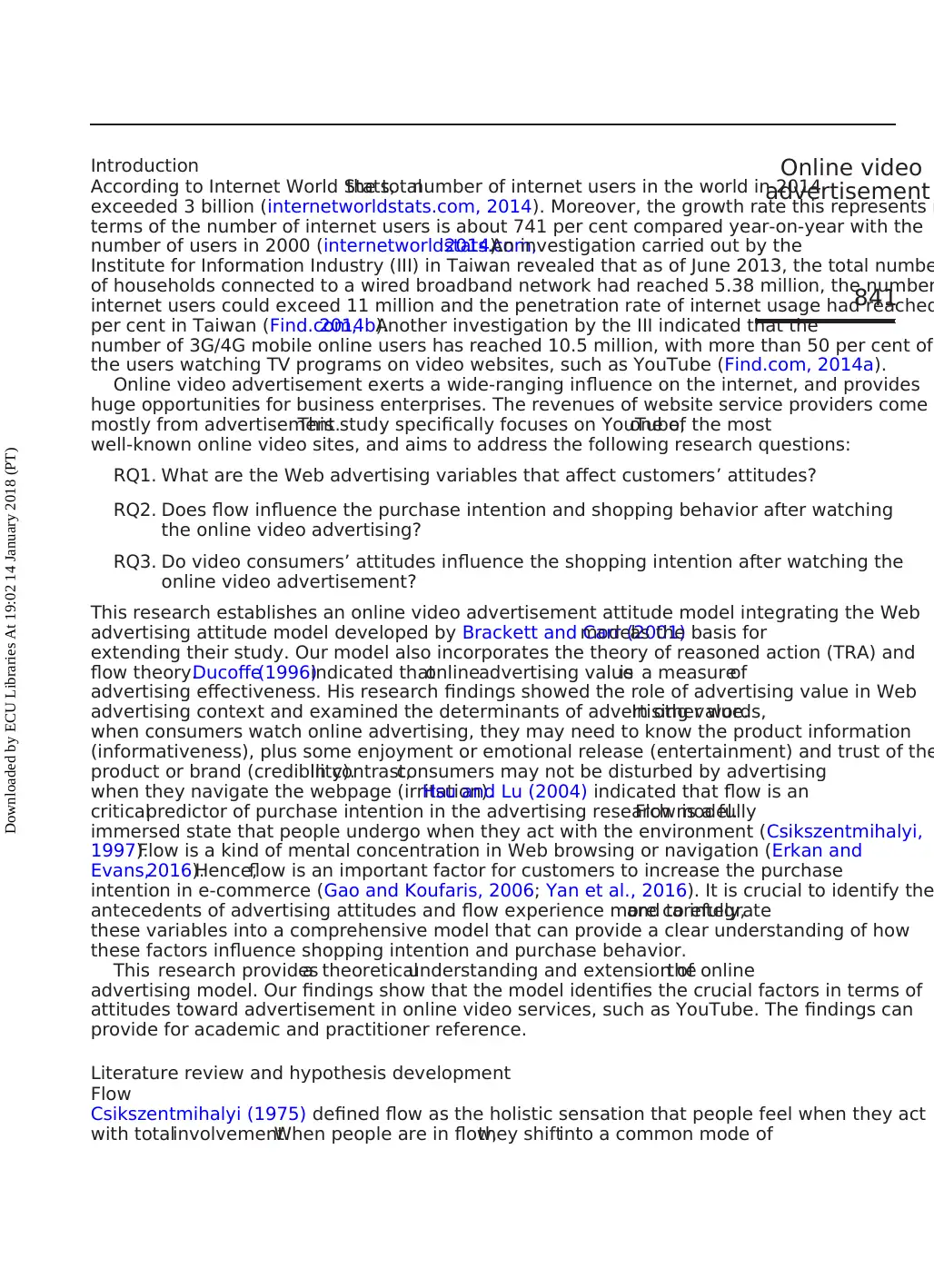
Introduction
According to Internet World Stats,the totalnumber of internet users in the world in 2014
exceeded 3 billion (internetworldstats.com, 2014). Moreover, the growth rate this represents i
terms of the number of internet users is about 741 per cent compared year-on-year with the
number of users in 2000 (internetworldstats.com,2014).An investigation carried out by the
Institute for Information Industry (III) in Taiwan revealed that as of June 2013, the total numbe
of households connected to a wired broadband network had reached 5.38 million, the number
internet users could exceed 11 million and the penetration rate of internet usage had reached
per cent in Taiwan (Find.com,2014b).Another investigation by the III indicated that the
number of 3G/4G mobile online users has reached 10.5 million, with more than 50 per cent of
the users watching TV programs on video websites, such as YouTube (Find.com, 2014a).
Online video advertisement exerts a wide-ranging influence on the internet, and provides
huge opportunities for business enterprises. The revenues of website service providers come
mostly from advertisement.This study specifically focuses on YouTube,one of the most
well-known online video sites, and aims to address the following research questions:
RQ1. What are the Web advertising variables that affect customers’ attitudes?
RQ2. Does flow influence the purchase intention and shopping behavior after watching
the online video advertising?
RQ3. Do video consumers’ attitudes influence the shopping intention after watching the
online video advertisement?
This research establishes an online video advertisement attitude model integrating the Web
advertising attitude model developed by Brackett and Carr (2001)modelas the basis for
extending their study. Our model also incorporates the theory of reasoned action (TRA) and
flow theory.Ducoffe(1996)indicated thatonlineadvertising valueis a measureof
advertising effectiveness. His research findings showed the role of advertising value in Web
advertising context and examined the determinants of advertising value.In other words,
when consumers watch online advertising, they may need to know the product information
(informativeness), plus some enjoyment or emotional release (entertainment) and trust of the
product or brand (credibility).In contrast,consumers may not be disturbed by advertising
when they navigate the webpage (irritation).Hsu and Lu (2004) indicated that flow is an
criticalpredictor of purchase intention in the advertising research model.Flow is a fully
immersed state that people undergo when they act with the environment (Csikszentmihalyi,
1997).Flow is a kind of mental concentration in Web browsing or navigation (Erkan and
Evans,2016).Hence,flow is an important factor for customers to increase the purchase
intention in e-commerce (Gao and Koufaris, 2006; Yan et al., 2016). It is crucial to identify the
antecedents of advertising attitudes and flow experience more carefully,and to integrate
these variables into a comprehensive model that can provide a clear understanding of how
these factors influence shopping intention and purchase behavior.
This research providesa theoreticalunderstanding and extension ofthe online
advertising model. Our findings show that the model identifies the crucial factors in terms of
attitudes toward advertisement in online video services, such as YouTube. The findings can
provide for academic and practitioner reference.
Literature review and hypothesis development
Flow
Csikszentmihalyi (1975) defined flow as the holistic sensation that people feel when they act
with totalinvolvement.When people are in flow,they shiftinto a common mode of
Online video
advertisement
841
Downloaded by ECU Libraries At 19:02 14 January 2018 (PT)
According to Internet World Stats,the totalnumber of internet users in the world in 2014
exceeded 3 billion (internetworldstats.com, 2014). Moreover, the growth rate this represents i
terms of the number of internet users is about 741 per cent compared year-on-year with the
number of users in 2000 (internetworldstats.com,2014).An investigation carried out by the
Institute for Information Industry (III) in Taiwan revealed that as of June 2013, the total numbe
of households connected to a wired broadband network had reached 5.38 million, the number
internet users could exceed 11 million and the penetration rate of internet usage had reached
per cent in Taiwan (Find.com,2014b).Another investigation by the III indicated that the
number of 3G/4G mobile online users has reached 10.5 million, with more than 50 per cent of
the users watching TV programs on video websites, such as YouTube (Find.com, 2014a).
Online video advertisement exerts a wide-ranging influence on the internet, and provides
huge opportunities for business enterprises. The revenues of website service providers come
mostly from advertisement.This study specifically focuses on YouTube,one of the most
well-known online video sites, and aims to address the following research questions:
RQ1. What are the Web advertising variables that affect customers’ attitudes?
RQ2. Does flow influence the purchase intention and shopping behavior after watching
the online video advertising?
RQ3. Do video consumers’ attitudes influence the shopping intention after watching the
online video advertisement?
This research establishes an online video advertisement attitude model integrating the Web
advertising attitude model developed by Brackett and Carr (2001)modelas the basis for
extending their study. Our model also incorporates the theory of reasoned action (TRA) and
flow theory.Ducoffe(1996)indicated thatonlineadvertising valueis a measureof
advertising effectiveness. His research findings showed the role of advertising value in Web
advertising context and examined the determinants of advertising value.In other words,
when consumers watch online advertising, they may need to know the product information
(informativeness), plus some enjoyment or emotional release (entertainment) and trust of the
product or brand (credibility).In contrast,consumers may not be disturbed by advertising
when they navigate the webpage (irritation).Hsu and Lu (2004) indicated that flow is an
criticalpredictor of purchase intention in the advertising research model.Flow is a fully
immersed state that people undergo when they act with the environment (Csikszentmihalyi,
1997).Flow is a kind of mental concentration in Web browsing or navigation (Erkan and
Evans,2016).Hence,flow is an important factor for customers to increase the purchase
intention in e-commerce (Gao and Koufaris, 2006; Yan et al., 2016). It is crucial to identify the
antecedents of advertising attitudes and flow experience more carefully,and to integrate
these variables into a comprehensive model that can provide a clear understanding of how
these factors influence shopping intention and purchase behavior.
This research providesa theoreticalunderstanding and extension ofthe online
advertising model. Our findings show that the model identifies the crucial factors in terms of
attitudes toward advertisement in online video services, such as YouTube. The findings can
provide for academic and practitioner reference.
Literature review and hypothesis development
Flow
Csikszentmihalyi (1975) defined flow as the holistic sensation that people feel when they act
with totalinvolvement.When people are in flow,they shiftinto a common mode of
Online video
advertisement
841
Downloaded by ECU Libraries At 19:02 14 January 2018 (PT)
Paraphrase This Document
Need a fresh take? Get an instant paraphrase of this document with our AI Paraphraser
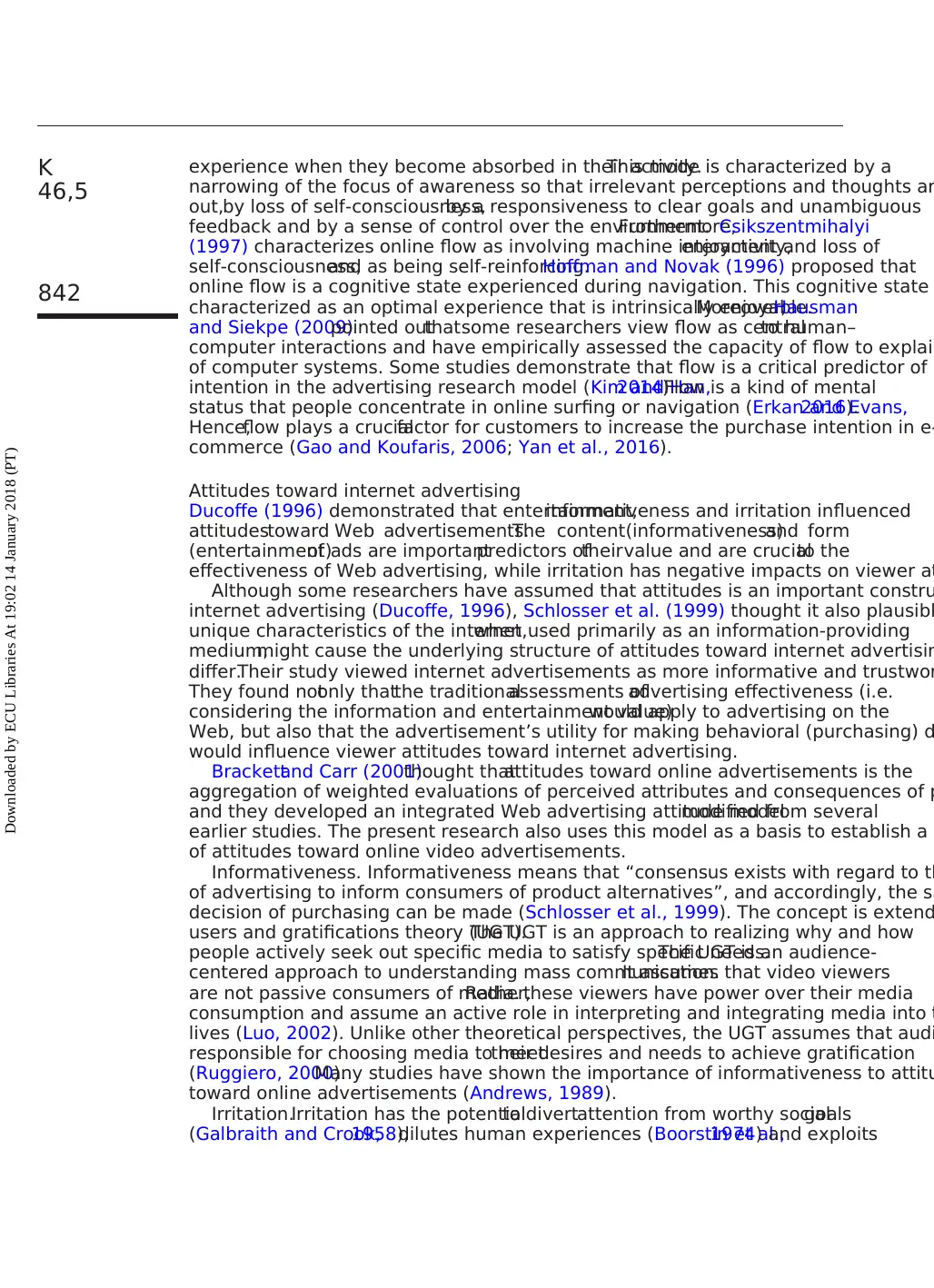
experience when they become absorbed in their activity.This mode is characterized by a
narrowing of the focus of awareness so that irrelevant perceptions and thoughts ar
out,by loss of self-consciousness,by a responsiveness to clear goals and unambiguous
feedback and by a sense of control over the environment.Furthermore,Csikszentmihalyi
(1997) characterizes online flow as involving machine interactivity,enjoyment and loss of
self-consciousness,and as being self-reinforcing.Hoffman and Novak (1996) proposed that
online flow is a cognitive state experienced during navigation. This cognitive state
characterized as an optimal experience that is intrinsically enjoyable.Moreover,Hausman
and Siekpe (2009)pointed outthatsome researchers view flow as centralto human–
computer interactions and have empirically assessed the capacity of flow to explain
of computer systems. Some studies demonstrate that flow is a critical predictor of p
intention in the advertising research model (Kim and Han,2014).Flow is a kind of mental
status that people concentrate in online surfing or navigation (Erkan and Evans,2016).
Hence,flow plays a crucialfactor for customers to increase the purchase intention in e-
commerce (Gao and Koufaris, 2006; Yan et al., 2016).
Attitudes toward internet advertising
Ducoffe (1996) demonstrated that entertainment,informativeness and irritation influenced
attitudestoward Web advertisements.The content(informativeness)and form
(entertainment)of ads are importantpredictors oftheirvalue and are crucialto the
effectiveness of Web advertising, while irritation has negative impacts on viewer at
Although some researchers have assumed that attitudes is an important constru
internet advertising (Ducoffe, 1996), Schlosser et al. (1999) thought it also plausibl
unique characteristics of the internet,when used primarily as an information-providing
medium,might cause the underlying structure of attitudes toward internet advertisin
differ.Their study viewed internet advertisements as more informative and trustwor
They found notonly thatthe traditionalassessments ofadvertising effectiveness (i.e.
considering the information and entertainment value)would apply to advertising on the
Web, but also that the advertisement’s utility for making behavioral (purchasing) d
would influence viewer attitudes toward internet advertising.
Brackettand Carr (2001)thought thatattitudes toward online advertisements is the
aggregation of weighted evaluations of perceived attributes and consequences of p
and they developed an integrated Web advertising attitude modelmodified from several
earlier studies. The present research also uses this model as a basis to establish a
of attitudes toward online video advertisements.
Informativeness. Informativeness means that “consensus exists with regard to th
of advertising to inform consumers of product alternatives”, and accordingly, the sa
decision of purchasing can be made (Schlosser et al., 1999). The concept is extend
users and gratifications theory (UGT).The UGT is an approach to realizing why and how
people actively seek out specific media to satisfy specific needs.The UGT is an audience-
centered approach to understanding mass communication.It assumes that video viewers
are not passive consumers of media.Rather,these viewers have power over their media
consumption and assume an active role in interpreting and integrating media into t
lives (Luo, 2002). Unlike other theoretical perspectives, the UGT assumes that audi
responsible for choosing media to meettheir desires and needs to achieve gratification
(Ruggiero, 2000).Many studies have shown the importance of informativeness to attitu
toward online advertisements (Andrews, 1989).
Irritation.Irritation has the potentialto divertattention from worthy socialgoals
(Galbraith and Crook,1958),dilutes human experiences (Boorstin et al.,1974) and exploits
K
46,5
842
Downloaded by ECU Libraries At 19:02 14 January 2018 (PT)
narrowing of the focus of awareness so that irrelevant perceptions and thoughts ar
out,by loss of self-consciousness,by a responsiveness to clear goals and unambiguous
feedback and by a sense of control over the environment.Furthermore,Csikszentmihalyi
(1997) characterizes online flow as involving machine interactivity,enjoyment and loss of
self-consciousness,and as being self-reinforcing.Hoffman and Novak (1996) proposed that
online flow is a cognitive state experienced during navigation. This cognitive state
characterized as an optimal experience that is intrinsically enjoyable.Moreover,Hausman
and Siekpe (2009)pointed outthatsome researchers view flow as centralto human–
computer interactions and have empirically assessed the capacity of flow to explain
of computer systems. Some studies demonstrate that flow is a critical predictor of p
intention in the advertising research model (Kim and Han,2014).Flow is a kind of mental
status that people concentrate in online surfing or navigation (Erkan and Evans,2016).
Hence,flow plays a crucialfactor for customers to increase the purchase intention in e-
commerce (Gao and Koufaris, 2006; Yan et al., 2016).
Attitudes toward internet advertising
Ducoffe (1996) demonstrated that entertainment,informativeness and irritation influenced
attitudestoward Web advertisements.The content(informativeness)and form
(entertainment)of ads are importantpredictors oftheirvalue and are crucialto the
effectiveness of Web advertising, while irritation has negative impacts on viewer at
Although some researchers have assumed that attitudes is an important constru
internet advertising (Ducoffe, 1996), Schlosser et al. (1999) thought it also plausibl
unique characteristics of the internet,when used primarily as an information-providing
medium,might cause the underlying structure of attitudes toward internet advertisin
differ.Their study viewed internet advertisements as more informative and trustwor
They found notonly thatthe traditionalassessments ofadvertising effectiveness (i.e.
considering the information and entertainment value)would apply to advertising on the
Web, but also that the advertisement’s utility for making behavioral (purchasing) d
would influence viewer attitudes toward internet advertising.
Brackettand Carr (2001)thought thatattitudes toward online advertisements is the
aggregation of weighted evaluations of perceived attributes and consequences of p
and they developed an integrated Web advertising attitude modelmodified from several
earlier studies. The present research also uses this model as a basis to establish a
of attitudes toward online video advertisements.
Informativeness. Informativeness means that “consensus exists with regard to th
of advertising to inform consumers of product alternatives”, and accordingly, the sa
decision of purchasing can be made (Schlosser et al., 1999). The concept is extend
users and gratifications theory (UGT).The UGT is an approach to realizing why and how
people actively seek out specific media to satisfy specific needs.The UGT is an audience-
centered approach to understanding mass communication.It assumes that video viewers
are not passive consumers of media.Rather,these viewers have power over their media
consumption and assume an active role in interpreting and integrating media into t
lives (Luo, 2002). Unlike other theoretical perspectives, the UGT assumes that audi
responsible for choosing media to meettheir desires and needs to achieve gratification
(Ruggiero, 2000).Many studies have shown the importance of informativeness to attitu
toward online advertisements (Andrews, 1989).
Irritation.Irritation has the potentialto divertattention from worthy socialgoals
(Galbraith and Crook,1958),dilutes human experiences (Boorstin et al.,1974) and exploits
K
46,5
842
Downloaded by ECU Libraries At 19:02 14 January 2018 (PT)
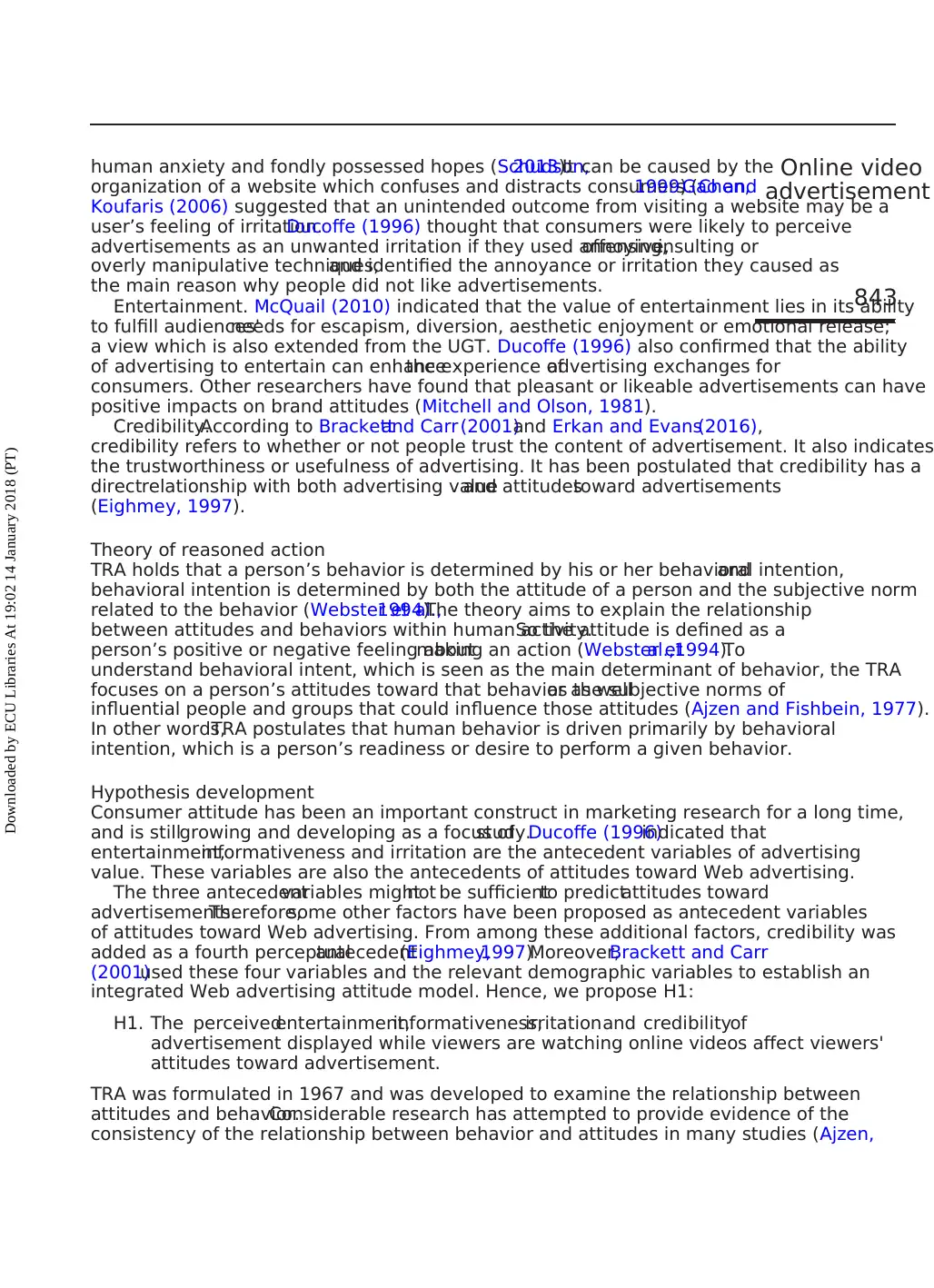
human anxiety and fondly possessed hopes (Schudson,2013).It can be caused by the
organization of a website which confuses and distracts consumers (Chen,1999).Gao and
Koufaris (2006) suggested that an unintended outcome from visiting a website may be a
user’s feeling of irritation.Ducoffe (1996) thought that consumers were likely to perceive
advertisements as an unwanted irritation if they used annoying,offensive,insulting or
overly manipulative techniques,and identified the annoyance or irritation they caused as
the main reason why people did not like advertisements.
Entertainment. McQuail (2010) indicated that the value of entertainment lies in its ability
to fulfill audiences'needs for escapism, diversion, aesthetic enjoyment or emotional release;
a view which is also extended from the UGT. Ducoffe (1996) also confirmed that the ability
of advertising to entertain can enhancethe experience ofadvertising exchanges for
consumers. Other researchers have found that pleasant or likeable advertisements can have
positive impacts on brand attitudes (Mitchell and Olson, 1981).
Credibility.According to Brackettand Carr (2001)and Erkan and Evans(2016),
credibility refers to whether or not people trust the content of advertisement. It also indicates
the trustworthiness or usefulness of advertising. It has been postulated that credibility has a
directrelationship with both advertising valueand attitudestoward advertisements
(Eighmey, 1997).
Theory of reasoned action
TRA holds that a person’s behavior is determined by his or her behavioral intention,and
behavioral intention is determined by both the attitude of a person and the subjective norm
related to the behavior (Webster et al.,1994).The theory aims to explain the relationship
between attitudes and behaviors within human activity.So the attitude is defined as a
person’s positive or negative feeling aboutmaking an action (Webster etal.,1994).To
understand behavioral intent, which is seen as the main determinant of behavior, the TRA
focuses on a person’s attitudes toward that behavior as wellas the subjective norms of
influential people and groups that could influence those attitudes (Ajzen and Fishbein, 1977).
In other words,TRA postulates that human behavior is driven primarily by behavioral
intention, which is a person’s readiness or desire to perform a given behavior.
Hypothesis development
Consumer attitude has been an important construct in marketing research for a long time,
and is stillgrowing and developing as a focus ofstudy.Ducoffe (1996)indicated that
entertainment,informativeness and irritation are the antecedent variables of advertising
value. These variables are also the antecedents of attitudes toward Web advertising.
The three antecedentvariables mightnot be sufficientto predictattitudes toward
advertisements.Therefore,some other factors have been proposed as antecedent variables
of attitudes toward Web advertising. From among these additional factors, credibility was
added as a fourth perceptualantecedent(Eighmey,1997).Moreover,Brackett and Carr
(2001)used these four variables and the relevant demographic variables to establish an
integrated Web advertising attitude model. Hence, we propose H1:
H1. The perceivedentertainment,informativeness,irritationand credibilityof
advertisement displayed while viewers are watching online videos affect viewers'
attitudes toward advertisement.
TRA was formulated in 1967 and was developed to examine the relationship between
attitudes and behavior.Considerable research has attempted to provide evidence of the
consistency of the relationship between behavior and attitudes in many studies (Ajzen,
Online video
advertisement
843
Downloaded by ECU Libraries At 19:02 14 January 2018 (PT)
organization of a website which confuses and distracts consumers (Chen,1999).Gao and
Koufaris (2006) suggested that an unintended outcome from visiting a website may be a
user’s feeling of irritation.Ducoffe (1996) thought that consumers were likely to perceive
advertisements as an unwanted irritation if they used annoying,offensive,insulting or
overly manipulative techniques,and identified the annoyance or irritation they caused as
the main reason why people did not like advertisements.
Entertainment. McQuail (2010) indicated that the value of entertainment lies in its ability
to fulfill audiences'needs for escapism, diversion, aesthetic enjoyment or emotional release;
a view which is also extended from the UGT. Ducoffe (1996) also confirmed that the ability
of advertising to entertain can enhancethe experience ofadvertising exchanges for
consumers. Other researchers have found that pleasant or likeable advertisements can have
positive impacts on brand attitudes (Mitchell and Olson, 1981).
Credibility.According to Brackettand Carr (2001)and Erkan and Evans(2016),
credibility refers to whether or not people trust the content of advertisement. It also indicates
the trustworthiness or usefulness of advertising. It has been postulated that credibility has a
directrelationship with both advertising valueand attitudestoward advertisements
(Eighmey, 1997).
Theory of reasoned action
TRA holds that a person’s behavior is determined by his or her behavioral intention,and
behavioral intention is determined by both the attitude of a person and the subjective norm
related to the behavior (Webster et al.,1994).The theory aims to explain the relationship
between attitudes and behaviors within human activity.So the attitude is defined as a
person’s positive or negative feeling aboutmaking an action (Webster etal.,1994).To
understand behavioral intent, which is seen as the main determinant of behavior, the TRA
focuses on a person’s attitudes toward that behavior as wellas the subjective norms of
influential people and groups that could influence those attitudes (Ajzen and Fishbein, 1977).
In other words,TRA postulates that human behavior is driven primarily by behavioral
intention, which is a person’s readiness or desire to perform a given behavior.
Hypothesis development
Consumer attitude has been an important construct in marketing research for a long time,
and is stillgrowing and developing as a focus ofstudy.Ducoffe (1996)indicated that
entertainment,informativeness and irritation are the antecedent variables of advertising
value. These variables are also the antecedents of attitudes toward Web advertising.
The three antecedentvariables mightnot be sufficientto predictattitudes toward
advertisements.Therefore,some other factors have been proposed as antecedent variables
of attitudes toward Web advertising. From among these additional factors, credibility was
added as a fourth perceptualantecedent(Eighmey,1997).Moreover,Brackett and Carr
(2001)used these four variables and the relevant demographic variables to establish an
integrated Web advertising attitude model. Hence, we propose H1:
H1. The perceivedentertainment,informativeness,irritationand credibilityof
advertisement displayed while viewers are watching online videos affect viewers'
attitudes toward advertisement.
TRA was formulated in 1967 and was developed to examine the relationship between
attitudes and behavior.Considerable research has attempted to provide evidence of the
consistency of the relationship between behavior and attitudes in many studies (Ajzen,
Online video
advertisement
843
Downloaded by ECU Libraries At 19:02 14 January 2018 (PT)
⊘ This is a preview!⊘
Do you want full access?
Subscribe today to unlock all pages.

Trusted by 1+ million students worldwide
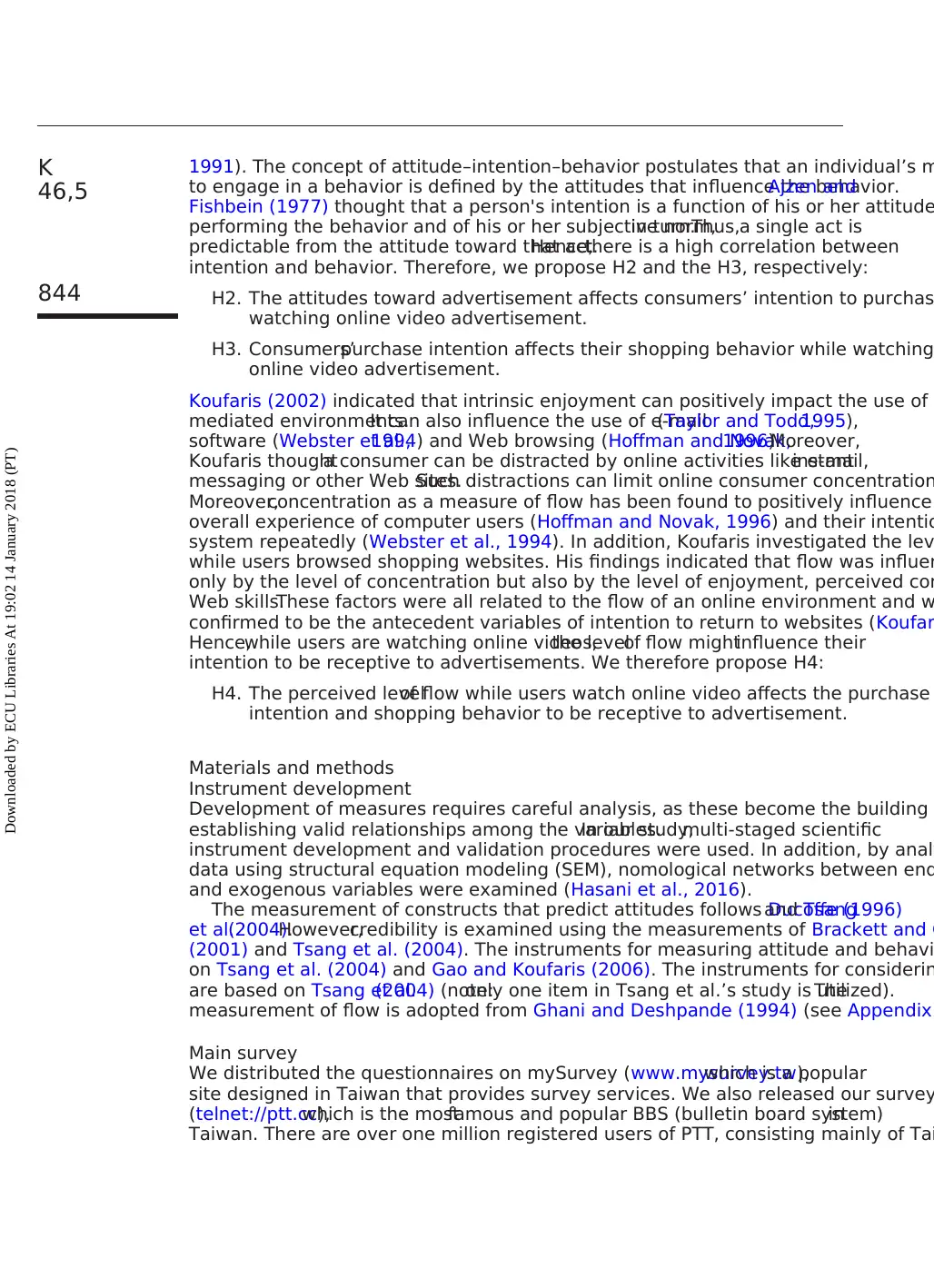
1991). The concept of attitude–intention–behavior postulates that an individual’s m
to engage in a behavior is defined by the attitudes that influence the behavior.Ajzen and
Fishbein (1977) thought that a person's intention is a function of his or her attitude
performing the behavior and of his or her subjective norm,in turn.Thus,a single act is
predictable from the attitude toward that act.Hence,there is a high correlation between
intention and behavior. Therefore, we propose H2 and the H3, respectively:
H2. The attitudes toward advertisement affects consumers’ intention to purchas
watching online video advertisement.
H3. Consumers’purchase intention affects their shopping behavior while watching
online video advertisement.
Koufaris (2002) indicated that intrinsic enjoyment can positively impact the use of
mediated environments.It can also influence the use of e-mail(Taylor and Todd,1995),
software (Webster et al.,1994) and Web browsing (Hoffman and Novak,1996).Moreover,
Koufaris thoughta consumer can be distracted by online activities like e-mail,instant
messaging or other Web sites.Such distractions can limit online consumer concentration
Moreover,concentration as a measure of flow has been found to positively influence
overall experience of computer users (Hoffman and Novak, 1996) and their intentio
system repeatedly (Webster et al., 1994). In addition, Koufaris investigated the lev
while users browsed shopping websites. His findings indicated that flow was influen
only by the level of concentration but also by the level of enjoyment, perceived con
Web skills.These factors were all related to the flow of an online environment and w
confirmed to be the antecedent variables of intention to return to websites (Koufar
Hence,while users are watching online videos,the levelof flow mightinfluence their
intention to be receptive to advertisements. We therefore propose H4:
H4. The perceived levelof flow while users watch online video affects the purchase
intention and shopping behavior to be receptive to advertisement.
Materials and methods
Instrument development
Development of measures requires careful analysis, as these become the building
establishing valid relationships among the variables.In our study,multi-staged scientific
instrument development and validation procedures were used. In addition, by analy
data using structural equation modeling (SEM), nomological networks between end
and exogenous variables were examined (Hasani et al., 2016).
The measurement of constructs that predict attitudes follows Ducoffe (1996)and Tsang
et al.(2004).However,credibility is examined using the measurements of Brackett and C
(2001) and Tsang et al. (2004). The instruments for measuring attitude and behavi
on Tsang et al. (2004) and Gao and Koufaris (2006). The instruments for considerin
are based on Tsang et al.(2004) (note:only one item in Tsang et al.’s study is utilized).The
measurement of flow is adopted from Ghani and Deshpande (1994) (see Appendix)
Main survey
We distributed the questionnaires on mySurvey (www.mysurvey.tw),which is a popular
site designed in Taiwan that provides survey services. We also released our survey
(telnet://ptt.cc),which is the mostfamous and popular BBS (bulletin board system)in
Taiwan. There are over one million registered users of PTT, consisting mainly of Tai
K
46,5
844
Downloaded by ECU Libraries At 19:02 14 January 2018 (PT)
to engage in a behavior is defined by the attitudes that influence the behavior.Ajzen and
Fishbein (1977) thought that a person's intention is a function of his or her attitude
performing the behavior and of his or her subjective norm,in turn.Thus,a single act is
predictable from the attitude toward that act.Hence,there is a high correlation between
intention and behavior. Therefore, we propose H2 and the H3, respectively:
H2. The attitudes toward advertisement affects consumers’ intention to purchas
watching online video advertisement.
H3. Consumers’purchase intention affects their shopping behavior while watching
online video advertisement.
Koufaris (2002) indicated that intrinsic enjoyment can positively impact the use of
mediated environments.It can also influence the use of e-mail(Taylor and Todd,1995),
software (Webster et al.,1994) and Web browsing (Hoffman and Novak,1996).Moreover,
Koufaris thoughta consumer can be distracted by online activities like e-mail,instant
messaging or other Web sites.Such distractions can limit online consumer concentration
Moreover,concentration as a measure of flow has been found to positively influence
overall experience of computer users (Hoffman and Novak, 1996) and their intentio
system repeatedly (Webster et al., 1994). In addition, Koufaris investigated the lev
while users browsed shopping websites. His findings indicated that flow was influen
only by the level of concentration but also by the level of enjoyment, perceived con
Web skills.These factors were all related to the flow of an online environment and w
confirmed to be the antecedent variables of intention to return to websites (Koufar
Hence,while users are watching online videos,the levelof flow mightinfluence their
intention to be receptive to advertisements. We therefore propose H4:
H4. The perceived levelof flow while users watch online video affects the purchase
intention and shopping behavior to be receptive to advertisement.
Materials and methods
Instrument development
Development of measures requires careful analysis, as these become the building
establishing valid relationships among the variables.In our study,multi-staged scientific
instrument development and validation procedures were used. In addition, by analy
data using structural equation modeling (SEM), nomological networks between end
and exogenous variables were examined (Hasani et al., 2016).
The measurement of constructs that predict attitudes follows Ducoffe (1996)and Tsang
et al.(2004).However,credibility is examined using the measurements of Brackett and C
(2001) and Tsang et al. (2004). The instruments for measuring attitude and behavi
on Tsang et al. (2004) and Gao and Koufaris (2006). The instruments for considerin
are based on Tsang et al.(2004) (note:only one item in Tsang et al.’s study is utilized).The
measurement of flow is adopted from Ghani and Deshpande (1994) (see Appendix)
Main survey
We distributed the questionnaires on mySurvey (www.mysurvey.tw),which is a popular
site designed in Taiwan that provides survey services. We also released our survey
(telnet://ptt.cc),which is the mostfamous and popular BBS (bulletin board system)in
Taiwan. There are over one million registered users of PTT, consisting mainly of Tai
K
46,5
844
Downloaded by ECU Libraries At 19:02 14 January 2018 (PT)
Paraphrase This Document
Need a fresh take? Get an instant paraphrase of this document with our AI Paraphraser
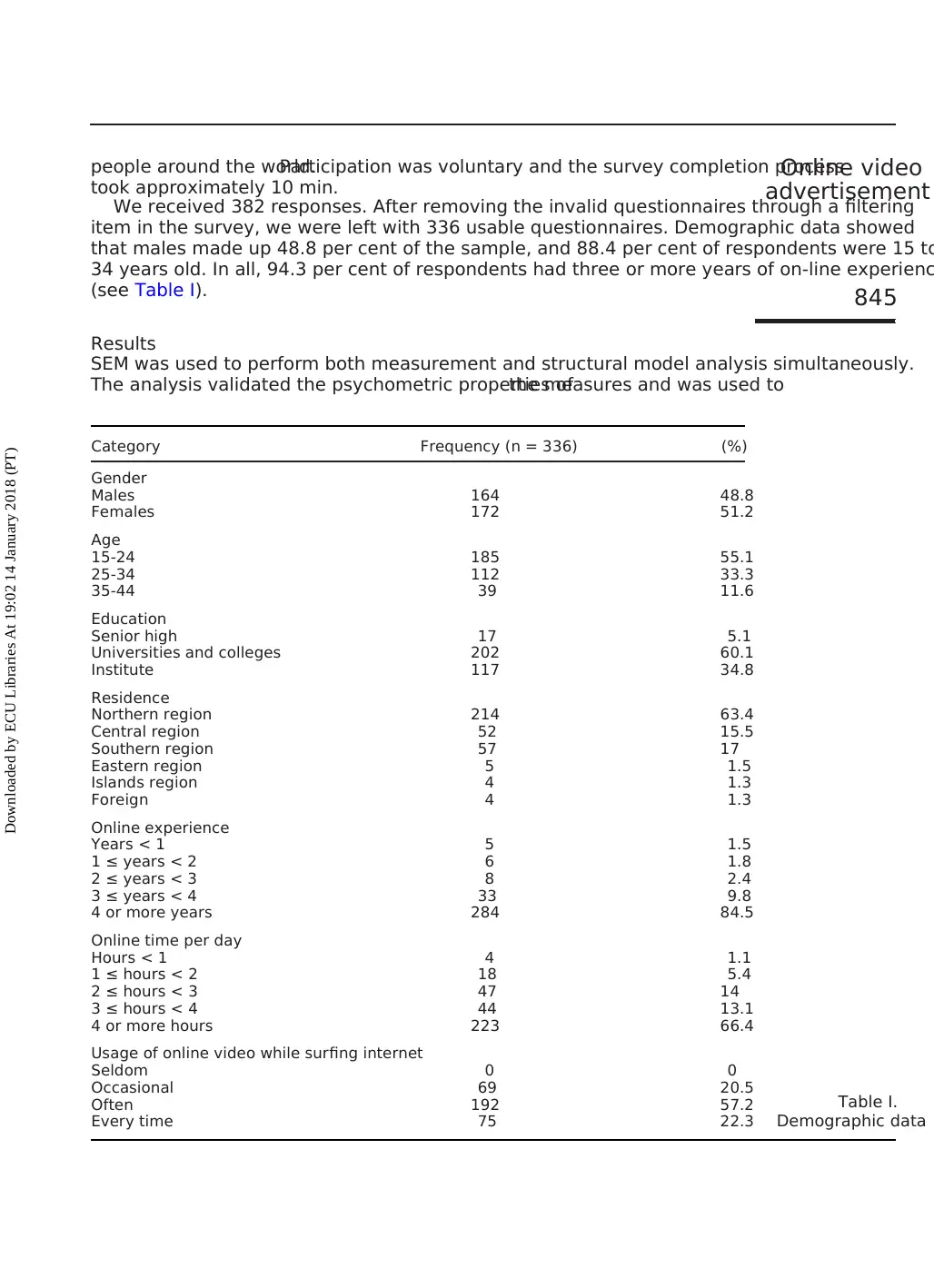
people around the world.Participation was voluntary and the survey completion process
took approximately 10 min.
We received 382 responses. After removing the invalid questionnaires through a filtering
item in the survey, we were left with 336 usable questionnaires. Demographic data showed
that males made up 48.8 per cent of the sample, and 88.4 per cent of respondents were 15 to
34 years old. In all, 94.3 per cent of respondents had three or more years of on-line experienc
(see Table I).
Results
SEM was used to perform both measurement and structural model analysis simultaneously.
The analysis validated the psychometric properties ofthe measures and was used to
Table I.
Demographic data
Category Frequency (n = 336) (%)
Gender
Males 164 48.8
Females 172 51.2
Age
15-24 185 55.1
25-34 112 33.3
35-44 39 11.6
Education
Senior high 17 5.1
Universities and colleges 202 60.1
Institute 117 34.8
Residence
Northern region 214 63.4
Central region 52 15.5
Southern region 57 17
Eastern region 5 1.5
Islands region 4 1.3
Foreign 4 1.3
Online experience
Years < 1 5 1.5
1 ≤ years < 2 6 1.8
2 ≤ years < 3 8 2.4
3 ≤ years < 4 33 9.8
4 or more years 284 84.5
Online time per day
Hours < 1 4 1.1
1 ≤ hours < 2 18 5.4
2 ≤ hours < 3 47 14
3 ≤ hours < 4 44 13.1
4 or more hours 223 66.4
Usage of online video while surfing internet
Seldom 0 0
Occasional 69 20.5
Often 192 57.2
Every time 75 22.3
Online video
advertisement
845
Downloaded by ECU Libraries At 19:02 14 January 2018 (PT)
took approximately 10 min.
We received 382 responses. After removing the invalid questionnaires through a filtering
item in the survey, we were left with 336 usable questionnaires. Demographic data showed
that males made up 48.8 per cent of the sample, and 88.4 per cent of respondents were 15 to
34 years old. In all, 94.3 per cent of respondents had three or more years of on-line experienc
(see Table I).
Results
SEM was used to perform both measurement and structural model analysis simultaneously.
The analysis validated the psychometric properties ofthe measures and was used to
Table I.
Demographic data
Category Frequency (n = 336) (%)
Gender
Males 164 48.8
Females 172 51.2
Age
15-24 185 55.1
25-34 112 33.3
35-44 39 11.6
Education
Senior high 17 5.1
Universities and colleges 202 60.1
Institute 117 34.8
Residence
Northern region 214 63.4
Central region 52 15.5
Southern region 57 17
Eastern region 5 1.5
Islands region 4 1.3
Foreign 4 1.3
Online experience
Years < 1 5 1.5
1 ≤ years < 2 6 1.8
2 ≤ years < 3 8 2.4
3 ≤ years < 4 33 9.8
4 or more years 284 84.5
Online time per day
Hours < 1 4 1.1
1 ≤ hours < 2 18 5.4
2 ≤ hours < 3 47 14
3 ≤ hours < 4 44 13.1
4 or more hours 223 66.4
Usage of online video while surfing internet
Seldom 0 0
Occasional 69 20.5
Often 192 57.2
Every time 75 22.3
Online video
advertisement
845
Downloaded by ECU Libraries At 19:02 14 January 2018 (PT)
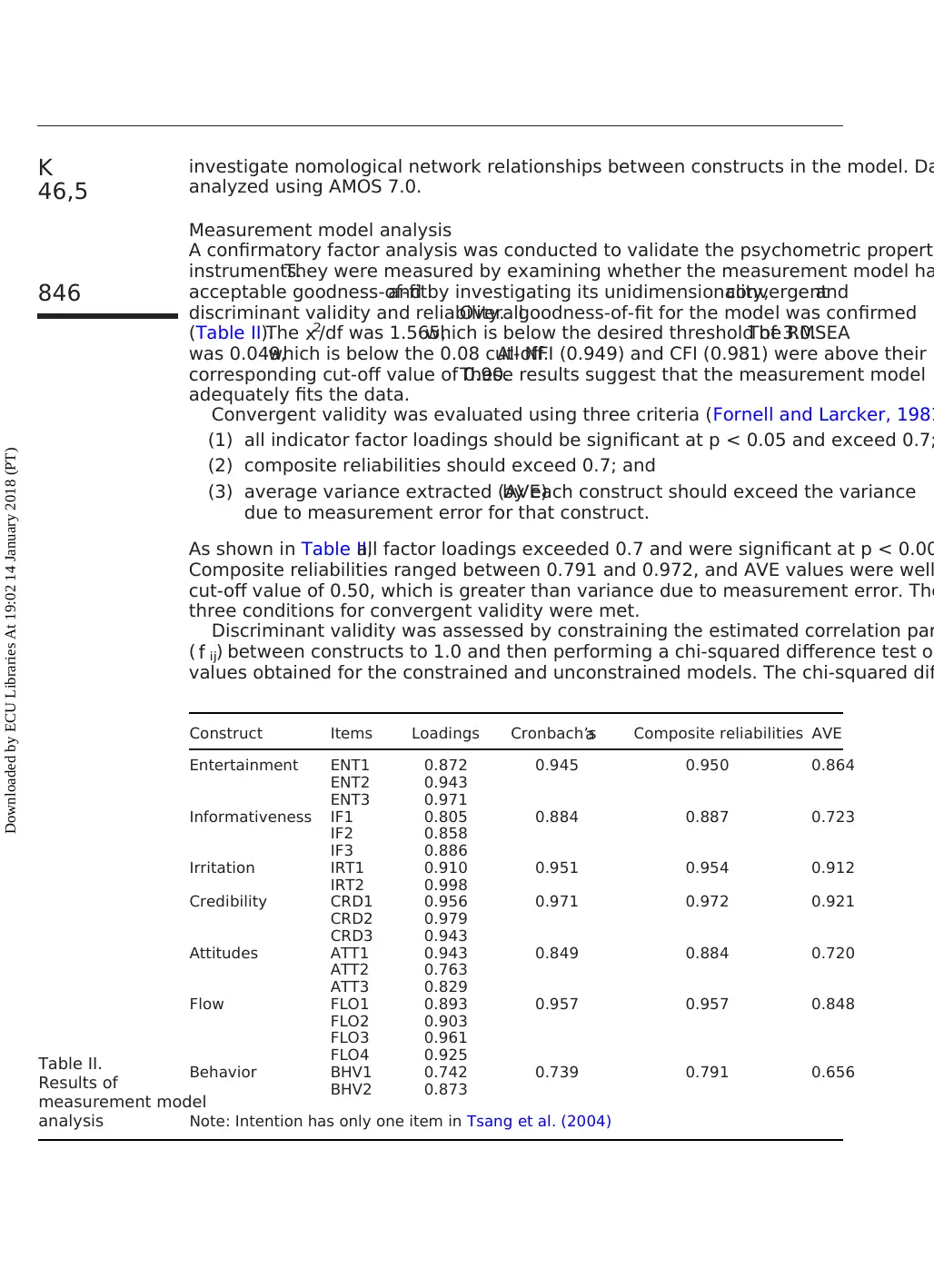
investigate nomological network relationships between constructs in the model. Da
analyzed using AMOS 7.0.
Measurement model analysis
A confirmatory factor analysis was conducted to validate the psychometric properti
instruments.They were measured by examining whether the measurement model ha
acceptable goodness-of-fitand by investigating its unidimensionality,convergentand
discriminant validity and reliability.Overallgoodness-of-fit for the model was confirmed
(Table II).The x2/df was 1.565,which is below the desired threshold of 3.0.The RMSEA
was 0.049,which is below the 0.08 cut-off.All NFI (0.949) and CFI (0.981) were above their
corresponding cut-off value of 0.90.These results suggest that the measurement model
adequately fits the data.
Convergent validity was evaluated using three criteria (Fornell and Larcker, 1981
(1) all indicator factor loadings should be significant at p < 0.05 and exceed 0.7;
(2) composite reliabilities should exceed 0.7; and
(3) average variance extracted (AVE)by each construct should exceed the variance
due to measurement error for that construct.
As shown in Table II,all factor loadings exceeded 0.7 and were significant at p < 0.00
Composite reliabilities ranged between 0.791 and 0.972, and AVE values were well
cut-off value of 0.50, which is greater than variance due to measurement error. The
three conditions for convergent validity were met.
Discriminant validity was assessed by constraining the estimated correlation par
( f ij) between constructs to 1.0 and then performing a chi-squared difference test on
values obtained for the constrained and unconstrained models. The chi-squared diff
Table II.
Results of
measurement model
analysis
Construct Items Loadings Cronbach’sa Composite reliabilities AVE
Entertainment ENT1
ENT2
ENT3
0.872
0.943
0.971
0.945 0.950 0.864
Informativeness IF1
IF2
IF3
0.805
0.858
0.886
0.884 0.887 0.723
Irritation IRT1
IRT2
0.910
0.998
0.951 0.954 0.912
Credibility CRD1
CRD2
CRD3
0.956
0.979
0.943
0.971 0.972 0.921
Attitudes ATT1
ATT2
ATT3
0.943
0.763
0.829
0.849 0.884 0.720
Flow FLO1
FLO2
FLO3
FLO4
0.893
0.903
0.961
0.925
0.957 0.957 0.848
Behavior BHV1
BHV2
0.742
0.873
0.739 0.791 0.656
Note: Intention has only one item in Tsang et al. (2004)
K
46,5
846
Downloaded by ECU Libraries At 19:02 14 January 2018 (PT)
analyzed using AMOS 7.0.
Measurement model analysis
A confirmatory factor analysis was conducted to validate the psychometric properti
instruments.They were measured by examining whether the measurement model ha
acceptable goodness-of-fitand by investigating its unidimensionality,convergentand
discriminant validity and reliability.Overallgoodness-of-fit for the model was confirmed
(Table II).The x2/df was 1.565,which is below the desired threshold of 3.0.The RMSEA
was 0.049,which is below the 0.08 cut-off.All NFI (0.949) and CFI (0.981) were above their
corresponding cut-off value of 0.90.These results suggest that the measurement model
adequately fits the data.
Convergent validity was evaluated using three criteria (Fornell and Larcker, 1981
(1) all indicator factor loadings should be significant at p < 0.05 and exceed 0.7;
(2) composite reliabilities should exceed 0.7; and
(3) average variance extracted (AVE)by each construct should exceed the variance
due to measurement error for that construct.
As shown in Table II,all factor loadings exceeded 0.7 and were significant at p < 0.00
Composite reliabilities ranged between 0.791 and 0.972, and AVE values were well
cut-off value of 0.50, which is greater than variance due to measurement error. The
three conditions for convergent validity were met.
Discriminant validity was assessed by constraining the estimated correlation par
( f ij) between constructs to 1.0 and then performing a chi-squared difference test on
values obtained for the constrained and unconstrained models. The chi-squared diff
Table II.
Results of
measurement model
analysis
Construct Items Loadings Cronbach’sa Composite reliabilities AVE
Entertainment ENT1
ENT2
ENT3
0.872
0.943
0.971
0.945 0.950 0.864
Informativeness IF1
IF2
IF3
0.805
0.858
0.886
0.884 0.887 0.723
Irritation IRT1
IRT2
0.910
0.998
0.951 0.954 0.912
Credibility CRD1
CRD2
CRD3
0.956
0.979
0.943
0.971 0.972 0.921
Attitudes ATT1
ATT2
ATT3
0.943
0.763
0.829
0.849 0.884 0.720
Flow FLO1
FLO2
FLO3
FLO4
0.893
0.903
0.961
0.925
0.957 0.957 0.848
Behavior BHV1
BHV2
0.742
0.873
0.739 0.791 0.656
Note: Intention has only one item in Tsang et al. (2004)
K
46,5
846
Downloaded by ECU Libraries At 19:02 14 January 2018 (PT)
⊘ This is a preview!⊘
Do you want full access?
Subscribe today to unlock all pages.

Trusted by 1+ million students worldwide
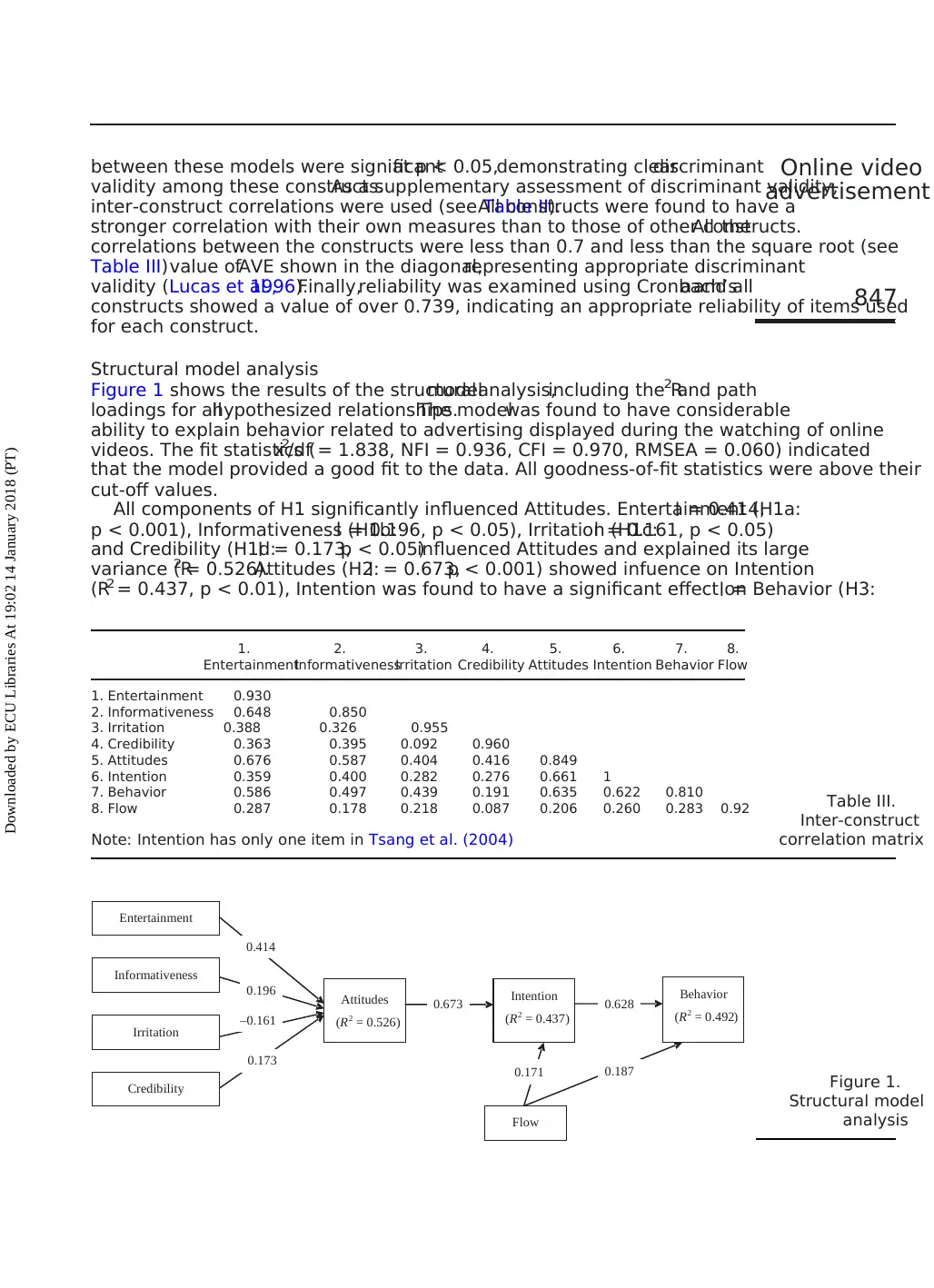
between these models were significantat p < 0.05,demonstrating cleardiscriminant
validity among these constructs.As a supplementary assessment of discriminant validity,
inter-construct correlations were used (see Table II).All constructs were found to have a
stronger correlation with their own measures than to those of other constructs.All the
correlations between the constructs were less than 0.7 and less than the square root (see
Table III)value ofAVE shown in the diagonal,representing appropriate discriminant
validity (Lucas et al.,1996).Finally,reliability was examined using Cronbach’saand all
constructs showed a value of over 0.739, indicating an appropriate reliability of items used
for each construct.
Structural model analysis
Figure 1 shows the results of the structuralmodelanalysis,including the R2 and path
loadings for allhypothesized relationships.The modelwas found to have considerable
ability to explain behavior related to advertising displayed during the watching of online
videos. The fit statistics (x2/df = 1.838, NFI = 0.936, CFI = 0.970, RMSEA = 0.060) indicated
that the model provided a good fit to the data. All goodness-of-fit statistics were above their
cut-off values.
All components of H1 significantly influenced Attitudes. Entertainment (H1a:l = 0.414,
p < 0.001), Informativeness (H1b:l = 0.196, p < 0.05), Irritation (H1c:l = 0.161, p < 0.05)
and Credibility (H1d:l = 0.173,p < 0.05)influenced Attitudes and explained its large
variance (R2 = 0.526).Attitudes (H2:l = 0.673,p < 0.001) showed infuence on Intention
(R2 = 0.437, p < 0.01), Intention was found to have a significant effect on Behavior (H3:l =
Figure 1.
Structural model
analysis
Entertainment
Irritation
Credibility
Informativeness
Attitudes
(R2 = 0.526)
Intention
(R2 = 0.437)
Behavior
(R2 = 0.492)
Flow
0.196
0.414
–0.161
0.173
0.673 0.628
0.1870.171
Table III.
Inter-construct
correlation matrix
1.
Entertainment
2.
Informativeness
3.
Irritation
4.
Credibility
5.
Attitudes
6.
Intention
7.
Behavior
8.
Flow
1. Entertainment 0.930
2. Informativeness 0.648 0.850
3. Irritation 0.388 0.326 0.955
4. Credibility 0.363 0.395 0.092 0.960
5. Attitudes 0.676 0.587 0.404 0.416 0.849
6. Intention 0.359 0.400 0.282 0.276 0.661 1
7. Behavior 0.586 0.497 0.439 0.191 0.635 0.622 0.810
8. Flow 0.287 0.178 0.218 0.087 0.206 0.260 0.283 0.92
Note: Intention has only one item in Tsang et al. (2004)
Online video
advertisement
847
Downloaded by ECU Libraries At 19:02 14 January 2018 (PT)
validity among these constructs.As a supplementary assessment of discriminant validity,
inter-construct correlations were used (see Table II).All constructs were found to have a
stronger correlation with their own measures than to those of other constructs.All the
correlations between the constructs were less than 0.7 and less than the square root (see
Table III)value ofAVE shown in the diagonal,representing appropriate discriminant
validity (Lucas et al.,1996).Finally,reliability was examined using Cronbach’saand all
constructs showed a value of over 0.739, indicating an appropriate reliability of items used
for each construct.
Structural model analysis
Figure 1 shows the results of the structuralmodelanalysis,including the R2 and path
loadings for allhypothesized relationships.The modelwas found to have considerable
ability to explain behavior related to advertising displayed during the watching of online
videos. The fit statistics (x2/df = 1.838, NFI = 0.936, CFI = 0.970, RMSEA = 0.060) indicated
that the model provided a good fit to the data. All goodness-of-fit statistics were above their
cut-off values.
All components of H1 significantly influenced Attitudes. Entertainment (H1a:l = 0.414,
p < 0.001), Informativeness (H1b:l = 0.196, p < 0.05), Irritation (H1c:l = 0.161, p < 0.05)
and Credibility (H1d:l = 0.173,p < 0.05)influenced Attitudes and explained its large
variance (R2 = 0.526).Attitudes (H2:l = 0.673,p < 0.001) showed infuence on Intention
(R2 = 0.437, p < 0.01), Intention was found to have a significant effect on Behavior (H3:l =
Figure 1.
Structural model
analysis
Entertainment
Irritation
Credibility
Informativeness
Attitudes
(R2 = 0.526)
Intention
(R2 = 0.437)
Behavior
(R2 = 0.492)
Flow
0.196
0.414
–0.161
0.173
0.673 0.628
0.1870.171
Table III.
Inter-construct
correlation matrix
1.
Entertainment
2.
Informativeness
3.
Irritation
4.
Credibility
5.
Attitudes
6.
Intention
7.
Behavior
8.
Flow
1. Entertainment 0.930
2. Informativeness 0.648 0.850
3. Irritation 0.388 0.326 0.955
4. Credibility 0.363 0.395 0.092 0.960
5. Attitudes 0.676 0.587 0.404 0.416 0.849
6. Intention 0.359 0.400 0.282 0.276 0.661 1
7. Behavior 0.586 0.497 0.439 0.191 0.635 0.622 0.810
8. Flow 0.287 0.178 0.218 0.087 0.206 0.260 0.283 0.92
Note: Intention has only one item in Tsang et al. (2004)
Online video
advertisement
847
Downloaded by ECU Libraries At 19:02 14 January 2018 (PT)
Paraphrase This Document
Need a fresh take? Get an instant paraphrase of this document with our AI Paraphraser

0.628, p < 0.001) and Flow had a positive influence on Intention (H4a:l = 0.171, p < 0.05)
and Behavior (H4b:l = 0.187, p < 0.05). As hypothesized in H4, Intention explained 49
cent of variances in Behavior. A summary of hypothesis test results is shown in Tab
Discussion
Our study shows thatthe proposed modelexplained mostof the variance in terms of
attitude toward advertisements on sites providing online video services, such as Yo
The results indicate thatthe model's appropriateness in the situation ofonline video
advertising is confirmed by the degree to which the findings are in accordance with
previous investigations in different areas,such as internet advertisements (Brackett and
Carr, 2001) and mobile advertisements (Tsang et al., 2004, Tai et al., 2016).
We found thatall the constituentelements ofH1, i.e.the perceived entertainment,
informativeness,irritation and credibility of advertisements displayed while viewers ar
watching onlinevideosaffectviewerattitudestoward theseadvertisements,were
supported.The constructshave a strong explanatory effecton attitude,especially
entertainment. Irritation was found to have a negative impact on attitudes. These fi
are consistent with previous research (Tsang et al., 2004).
In terms of its informativeness, our study verifies the UGT and confirms that aud
are responsible for choosing media to meettheir needs so as to achieve gratification.
Advertisements may be pleasant or likeable experiences for audiences.They can fulfill
audiences’needsfor escapism,diversion,aestheticenjoymentor emotionalrelease.
Advertisements provide credibility for audiences because viewers may trust the co
theseadvertisements.However,someaudiencesmay consideradvertisementsto be
annoying, offensive or irritating. This explains why many viewers tend not to like to
advertisements in the video.
Our findings reveal similar results in terms of flow.Flow does significantly influence
purchase intention and shopping behavior. Flow is an important factor of purchase
and shopping behavior in the online video advertising research model.People who watch
online video advertising may be absorbed by the information they are interested in
have intention to buy things or services (behavior). So when people are in a flow si
they may pay more attention on online video advertising.In other words, flow is a kind of
mental concentration in Web browsing or navigation (Erkan and Evans, 2016), espe
online video advertising. So flow is an important factor to increase the customers’ p
intention when they watch online video advertising.Our study confirms the relationship
among flow, intention and behavior. For instance, Koufaris (2002) confirmed that fl
positive impact on the intention to return to shopping websites.Hsu and Lu (2004)also
showed that the flow experience could predict the intention to play online games. L
(2009) investigated online e-learning users’acceptance behaviors in three contexts,such as
Table IV.
Summary of
hypothesis test
results
Hypotheses Path Results
H1a(þ) Entertainment Attitudes Supported
H1b(þ) Informativeness Attitudes Supported
H1c() Irritation Attitudes Supported
H1d(þ) Credibility Attitudes Supported
H2(þ) Attitudes Intention Supported
H3(þ) Intention Behavior Supported
H4a(þ) Flow Intention Supported
H4b(þ) Flow Behavior Supported
K
46,5
848
Downloaded by ECU Libraries At 19:02 14 January 2018 (PT)
and Behavior (H4b:l = 0.187, p < 0.05). As hypothesized in H4, Intention explained 49
cent of variances in Behavior. A summary of hypothesis test results is shown in Tab
Discussion
Our study shows thatthe proposed modelexplained mostof the variance in terms of
attitude toward advertisements on sites providing online video services, such as Yo
The results indicate thatthe model's appropriateness in the situation ofonline video
advertising is confirmed by the degree to which the findings are in accordance with
previous investigations in different areas,such as internet advertisements (Brackett and
Carr, 2001) and mobile advertisements (Tsang et al., 2004, Tai et al., 2016).
We found thatall the constituentelements ofH1, i.e.the perceived entertainment,
informativeness,irritation and credibility of advertisements displayed while viewers ar
watching onlinevideosaffectviewerattitudestoward theseadvertisements,were
supported.The constructshave a strong explanatory effecton attitude,especially
entertainment. Irritation was found to have a negative impact on attitudes. These fi
are consistent with previous research (Tsang et al., 2004).
In terms of its informativeness, our study verifies the UGT and confirms that aud
are responsible for choosing media to meettheir needs so as to achieve gratification.
Advertisements may be pleasant or likeable experiences for audiences.They can fulfill
audiences’needsfor escapism,diversion,aestheticenjoymentor emotionalrelease.
Advertisements provide credibility for audiences because viewers may trust the co
theseadvertisements.However,someaudiencesmay consideradvertisementsto be
annoying, offensive or irritating. This explains why many viewers tend not to like to
advertisements in the video.
Our findings reveal similar results in terms of flow.Flow does significantly influence
purchase intention and shopping behavior. Flow is an important factor of purchase
and shopping behavior in the online video advertising research model.People who watch
online video advertising may be absorbed by the information they are interested in
have intention to buy things or services (behavior). So when people are in a flow si
they may pay more attention on online video advertising.In other words, flow is a kind of
mental concentration in Web browsing or navigation (Erkan and Evans, 2016), espe
online video advertising. So flow is an important factor to increase the customers’ p
intention when they watch online video advertising.Our study confirms the relationship
among flow, intention and behavior. For instance, Koufaris (2002) confirmed that fl
positive impact on the intention to return to shopping websites.Hsu and Lu (2004)also
showed that the flow experience could predict the intention to play online games. L
(2009) investigated online e-learning users’acceptance behaviors in three contexts,such as
Table IV.
Summary of
hypothesis test
results
Hypotheses Path Results
H1a(þ) Entertainment Attitudes Supported
H1b(þ) Informativeness Attitudes Supported
H1c() Irritation Attitudes Supported
H1d(þ) Credibility Attitudes Supported
H2(þ) Attitudes Intention Supported
H3(þ) Intention Behavior Supported
H4a(þ) Flow Intention Supported
H4b(þ) Flow Behavior Supported
K
46,5
848
Downloaded by ECU Libraries At 19:02 14 January 2018 (PT)

text-audio, text-audio-video and audio-video, and found that flow was positively correlated
with intention to use the technology in the contexts of text–audio–video and audio–video.
This study reveals that attitudes influence purchase intention. Consumers with positive
attitudes on advertising may raise the intention to buy the goods or services. They may feel
that the advertising is informativeness,trust and enjoyable.These positive attitudes may
raise the intention of their shopping behaviors.When people have intention to shop after
watching online video advertising, they may have positive attitudes or enough confidence to
complete the purchase.This is why good advertising attracts people to watch it again and
again (repeatedly) because they generate good feelings for audiences when they watch the
advertising.
Theoretical contributions
There are several theoretical contributions from this research. First, this study reveals that
the attitudes ofonline video advertising influence shopping intention.When watching
online video advertising,people have good impression.This means thatthe contentof
advertising is attractive or reliable and consumers would pay attention to watch it.This
finding provides enough evidence to justify why good advertising is trustable for customer
not just only because of the impressiveness of the advertising but because of the trust or
reliability of the product or service.
Second, this study also justifies that flow plays an important role in shopping intention
and behavior. When people pay attention to watching online video advertising, they may be
absorbed by the productor serviceinformation.If peopleare willing to watch the
advertising,they may be attracted by the content and have intention or behavior to buy
things. In other words, this advertising may locate the potential target customers.
Finally, the research model of this study is based on the Brackett and Carr (2001) model
and combined with the TRA and flow theory. The results is consistent with the findings of
Brackett and Carr (2001). The online Web advertising factors have an influence on attitudes.
When people have enough information, enjoyment and trust when they watch online video
advertising,and hence,they may have positive attitudes for their shopping intention and
behavior.But if they feelthis advertising is irritable,this may reduce the willingness to
watch and they may not have intention to buy the goods or services.
For researchers,this study providesa comprehensivemodelfor onlinevideo
advertisements. This model was based on Brackett and Carr’s model, combining the UGT,
TRA and flow theory to develop an online video advertisement model.For future studies,
researchers can consider this model as a framework and use it to capture a more complete
picture of the relevant phenomena in their works.
Managerial implications
The purpose of online video advertising is to increase the sales of a product or service. So,
marketing managers may use different channels to demonstrate their advertising.Online
video advertising is now a popular way to deliver the product information to consumers. In
terms of the implications for practitioners,online video advertising managers can develop
their business strategies based on this study model.Managers may wish to rethink the
contextof their advertising,and consider taking steps to increase its informativeness,
entertainment value and credibility, while simultaneously reducing the level of irritation for
viewers.When audiences have great experiences on watching these video advertisements,
they may have positive attitudes and have greater shopping intention to buy (behavior).
Online video
advertisement
849
Downloaded by ECU Libraries At 19:02 14 January 2018 (PT)
with intention to use the technology in the contexts of text–audio–video and audio–video.
This study reveals that attitudes influence purchase intention. Consumers with positive
attitudes on advertising may raise the intention to buy the goods or services. They may feel
that the advertising is informativeness,trust and enjoyable.These positive attitudes may
raise the intention of their shopping behaviors.When people have intention to shop after
watching online video advertising, they may have positive attitudes or enough confidence to
complete the purchase.This is why good advertising attracts people to watch it again and
again (repeatedly) because they generate good feelings for audiences when they watch the
advertising.
Theoretical contributions
There are several theoretical contributions from this research. First, this study reveals that
the attitudes ofonline video advertising influence shopping intention.When watching
online video advertising,people have good impression.This means thatthe contentof
advertising is attractive or reliable and consumers would pay attention to watch it.This
finding provides enough evidence to justify why good advertising is trustable for customer
not just only because of the impressiveness of the advertising but because of the trust or
reliability of the product or service.
Second, this study also justifies that flow plays an important role in shopping intention
and behavior. When people pay attention to watching online video advertising, they may be
absorbed by the productor serviceinformation.If peopleare willing to watch the
advertising,they may be attracted by the content and have intention or behavior to buy
things. In other words, this advertising may locate the potential target customers.
Finally, the research model of this study is based on the Brackett and Carr (2001) model
and combined with the TRA and flow theory. The results is consistent with the findings of
Brackett and Carr (2001). The online Web advertising factors have an influence on attitudes.
When people have enough information, enjoyment and trust when they watch online video
advertising,and hence,they may have positive attitudes for their shopping intention and
behavior.But if they feelthis advertising is irritable,this may reduce the willingness to
watch and they may not have intention to buy the goods or services.
For researchers,this study providesa comprehensivemodelfor onlinevideo
advertisements. This model was based on Brackett and Carr’s model, combining the UGT,
TRA and flow theory to develop an online video advertisement model.For future studies,
researchers can consider this model as a framework and use it to capture a more complete
picture of the relevant phenomena in their works.
Managerial implications
The purpose of online video advertising is to increase the sales of a product or service. So,
marketing managers may use different channels to demonstrate their advertising.Online
video advertising is now a popular way to deliver the product information to consumers. In
terms of the implications for practitioners,online video advertising managers can develop
their business strategies based on this study model.Managers may wish to rethink the
contextof their advertising,and consider taking steps to increase its informativeness,
entertainment value and credibility, while simultaneously reducing the level of irritation for
viewers.When audiences have great experiences on watching these video advertisements,
they may have positive attitudes and have greater shopping intention to buy (behavior).
Online video
advertisement
849
Downloaded by ECU Libraries At 19:02 14 January 2018 (PT)
⊘ This is a preview!⊘
Do you want full access?
Subscribe today to unlock all pages.

Trusted by 1+ million students worldwide
1 out of 16
Your All-in-One AI-Powered Toolkit for Academic Success.
+13062052269
info@desklib.com
Available 24*7 on WhatsApp / Email
![[object Object]](/_next/static/media/star-bottom.7253800d.svg)
Unlock your academic potential
Copyright © 2020–2025 A2Z Services. All Rights Reserved. Developed and managed by ZUCOL.